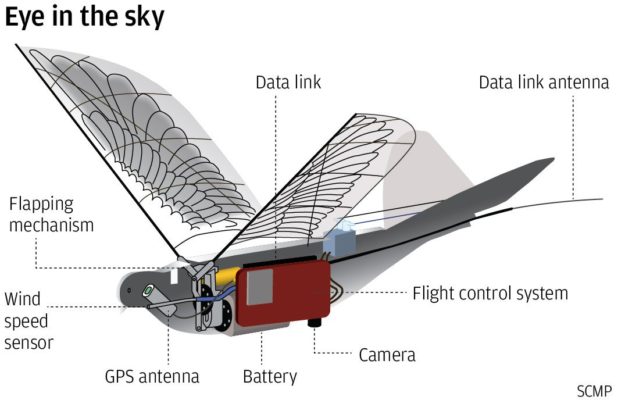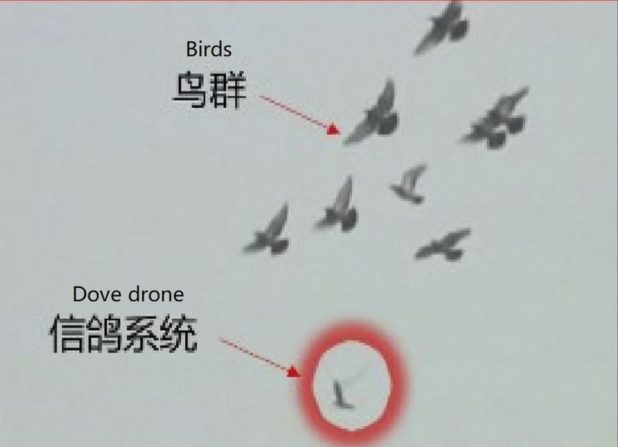Luis Castillo
Daily Stormer
August 4, 2018
Soon…
For now, the Chinese have not yet ordered their robot bird army to attack anyone who defies the Party.
I’m assuming that that will come later. I mean, the hard part is the battery life, fleet coordination, target identification, mass production, etc.
Once they get those issues solved, fitting them with shape charges and flying them at people will be pretty trivial.
For now, though, they’re just blending in with local wildlife, and watching you. Or, watching the Chinese, whatever.
Always watching.

George Orwell, 1984, Chapter 2:
‘Look!’ whispered Julia.
A thrush had alighted on a bough not five metres away, almost at the level of their faces. Perhaps it had not seen them. It was in the sun, they in the shade. It spread out its wings, fitted them carefully into place again, ducked its head for a moment, as though making a sort of obeisance to the sun, and then began to pour forth a torrent of song. In the afternoon hush the volume of sound was startling. Winston and Julia clung together, fascinated. The music went on and on, minute after minute, with astonishing variations, never once repeating itself, almost as though the bird were deliberately showing off its virtuosity. Sometimes it stopped for a few seconds, spread out and resettled its wings, then swelled its speckled breast and again burst into song. Winston watched it with a sort of vague reverence. For whom, for what, was that bird singing? No mate, no rival was watching it. What made it sit at the edge of the lonely wood and pour its music into nothingness?
He wondered whether after all there was a microphone hidden somewhere near. He and Julia had spoken only in low whispers, and it would not pick up what they had said, but it would pick up the thrush. Perhaps at the other end of the instrument some small, beetle-like man was listening intently — listening to that. But by degrees the flood of music drove all speculations out of his mind.
… Oh, wait.
That was the wrong link.
Sorry, guys. Here’s the thing.

If you’ve ever looked up to the sky and enjoyed the sight of a bird gliding above, be warned: it could be a Chinese drone monitoring your every move.
You know, this is kind of unsettling. I liked the George Orwell passage, better – definitely utopian, by comparison.
The idea might seem far fetched, but robotic birds are very much a reality, and China has been using them to surveil people across the country.
Sources told the South China Morning Post that more than 30 military and government agencies have deployed the birdlike drones and related devices in at least five provinces in recent years.
One part of the country that has seen the new technology used extensively is the Xinjiang Uygur autonomous region in China’s far west. The vast area, which borders Mongolia, Russia, Kazakhstan, Kyrgyzstan, Tajikistan, Afghanistan, Pakistan and India, is home to a large Muslim population and has long been viewed by Beijing as a hotbed for separatism. As a result, the region and its people have been subjected to heavy surveillance from the central government.
I’m honestly a lot more comfortable with the Chinese having this technology than our own Jewish overlords. I mean, at least they’re using them to spy on literal Moslem terrorists. If the EU got a hold of this, though…
I don’t want to think about it.
The new “spy birds” programme, code-named “Dove”, is being led by Song Bifeng, a professor at Northwestern Polytechnical University in Xian, capital of northwestern China’s Shaanxi province. Song was formerly a senior scientist on the J-20 stealth jet programme and has already been honoured by the People’s Liberation Army – China’s military – for his work on Dove, according to information on the university website.
Yang Wenqing, an associate professor at the School of Aeronautics at Northwestern and a member of Song’s team, confirmed the use of the new technology but said it was not widespread.
Yeah. Not yet.
“The scale is still small,” compared to other types of drones in use today, she told the South China Morning Post.
“We believe the technology has good potential for large-scale use in the future … it has some unique advantages to meet the demand for drones in the military and civilian sectors,” she said.
Unlike unmanned aerial vehicles with fixed wings or rotor blades, the new drones actually mimic the flapping action of a bird’s wings to climb, dive and turn in the air.
Another researcher involved in the Dove project said the aim was to develop a new generation of drones with biologically inspired engineering that could evade human detection and even radar.
These things will get predictably more life-like until you won’t even be able to tell the difference – and if they get sufficient solar cells they should be able to fly indefinitely.
The machines in China’s current robot flock replicate about 90 per cent of the movements of a real dove, the person said, adding that they also produce very little noise, making them very hard to detect from the ground, and are so lifelike that actual birds often fly alongside them.

…the Dove drones weigh 200 grams, have a wingspan of about 50 centimetres (20 inches), and can fly at speeds of up to 40km/h (25mph) for a maximum of 30 minutes.
These things are pretty much useless, then, until they can fix the power supply issue. Or, fine, not useless, but their operational range will be pretty limited.
I’ll give them a few years to give them solar units for indefinite flight and range.
Each machine is fitted with a high-definition camera, GPS antenna, flight control system and data link with satellite communication capability. The flapping mechanism comprises a pair of crank-rockers driven by an electric motor, while the wings themselves can deform slightly when moving up and down, which generates not only lift but also thrust to drive the drone forward.
Specially designed software helps to counter any jerky movements to ensure the on-board camera achieves sharp images and stable video.
The Dove drones’ ability to seemingly melt into the background has attracted a lot of interest in military and government circles.
Professor Li Yachao, a military radar researcher at the National Defence Technology Laboratory of Radar Signal Processing in Xian, said the movement of the Dove’s wings was so lifelike it could fool even the most sensitive radar systems.
The use of camouflage – perhaps even real feathers – on the drone’s outer body could distort the radar signature still further, he said.
Aware of the dangers such stealth drones pose to conventional detection systems, radar scientists have been looking at new ways to spot and track small, low-altitude targets flying at slow speed.
These include the holographic radar, which is capable of producing three-dimensional images of flying objects and has been hailed as a significant step forward in detection technology.
However, “there is no guarantee” that even a holographic radar – or any of the other new technologies in development – would be able to detect a drone with a wing-flapping pattern that was almost identical to those found in nature, and “especially if it was surrounded by other birds”, Li said.
“It would be a serious threat” to air defence systems, he said.
We need to get our own countries in order before our governments get their hands on this kind of technology.
Or, I mean, we can just sit around, smoking cigarettes and chatting, and pretending nothing is happening while the killer robot bird army silently masses in the distance.
Your call, guy.
‘Do you remember,’ he said, ‘the thrush that sang to us, that first day, at the edge of the wood?’
‘He wasn’t singing to us,’ said Julia. ‘He was singing to please himself. Not even that. He was just singing.’
The birds sang, the proles sang. The Party did not sing.
